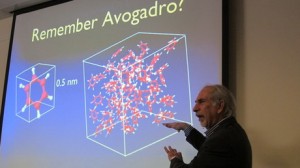
What are the smallest things we can see?
If you were a scientist with an atomic force microscope, you could look at things much smaller than a single human hair – a hair is 20,000 nanometers in diameter. Indeed, you could see, measure – and manipulate – atoms and molecules that are down on the one-nanometer scale.
How small is a nanometer? It takes 1,000,000,000, of them to equal the length of one meter (39 inches.
Welcome to the nano world of Edward T. Samulski, Cary Boshamer Professor of Chemistry at UNC-Chapel Hill, where he is designing nano scale applications that could revolutionize the performance of fuel cells and high-performance composites. He even founded a startup company in 2008, Allotropica Technologies, to further those developments.
Professor Samulski described nanotechnology to a rapt audience of Carolina Meadows residents recently. “Ironically, the all-important ‘nano’ is part of the metric system, a measuring system the U.S. refused to adopt some decades ago,” he observed. It seems we couldn’t bring ourselves to jettison inches, feet, yards and miles.
Matter has different properties when you get down to the nano level. Using a bar of gold as an example, Professor Samulski showed what could happen when you separate the surface atoms of gold from the interior bulk atoms. “The surface atoms no longer look gold, but red. We now know how the Romans in the 4th century A.D. produced their red glasses – they added ground up nanoparticles of gold to the glass mixture.”
Matter exhibits surprising behavior at the nano level – much of which is already proving very useful to us. One curious scientist wondered why lotus leaves didn’t absorb water. At the nano level he found protrusions that kept the water out. Voilà! “We now have NanoNuno umbrellas based on that structure,” Professor Samulski observed.
Another interesting development is self-cleaning windows. British scientists found that grime will not stick to the windows when a layer of nanoscale particles of titanium dioxide is applied to the glass. Instead, the sun will use the titanium dioxide particles to catalyze chemistry that burns away the dirt, and the rain will wash away any residue.
Moths and butterflies are yielding up secret nano-structures, too. Why are moths’ eyes black? At the nano level, a series of nano-scale conical protrusions on their hexagonal lenses don’t allow any reflection of light – and that concept is being used to make non-glare computer screens.
Butterfly wings have scales with structures that look like a series of trees at the nano level. These can fine-tune the wings’ colors anywhere from a brilliant orange to solid black depending on how far apart the “trees” are and how their “branches” are turned. This is having a direct application to the construction of solar cells with similar butterfly-like surfaces that trap all of the sunlight.
And then there are the different forms of carbon: diamond and graphite. Professor Samulski told us that you could slice off a one-atom thick layer of “graphene” and use its large surface area to support nanoparticles catalysts in hydrogen fuel cells. “This should lead to an improvement in performance efficiency, mechanical strength and the thermal management in this important component of a comprehensive energy strategy,” he said.
And this is just the beginning. We can’t even imagine how much nanotechnology will change our lives in the future.
By Rita Borden
